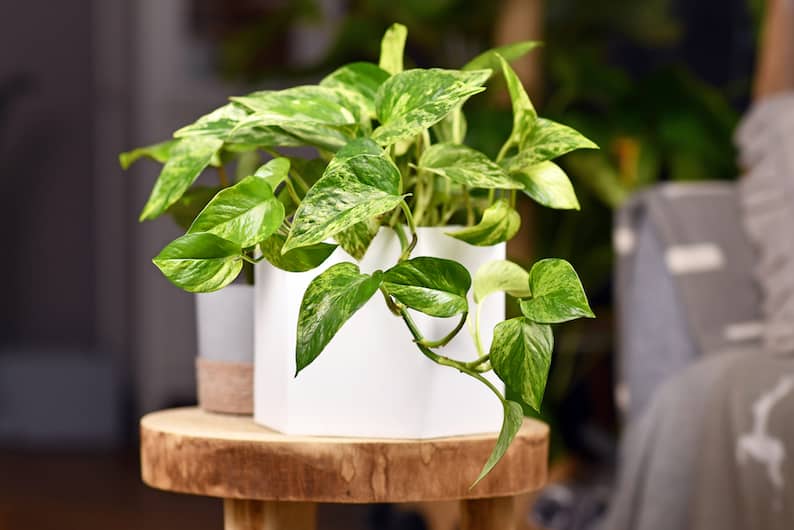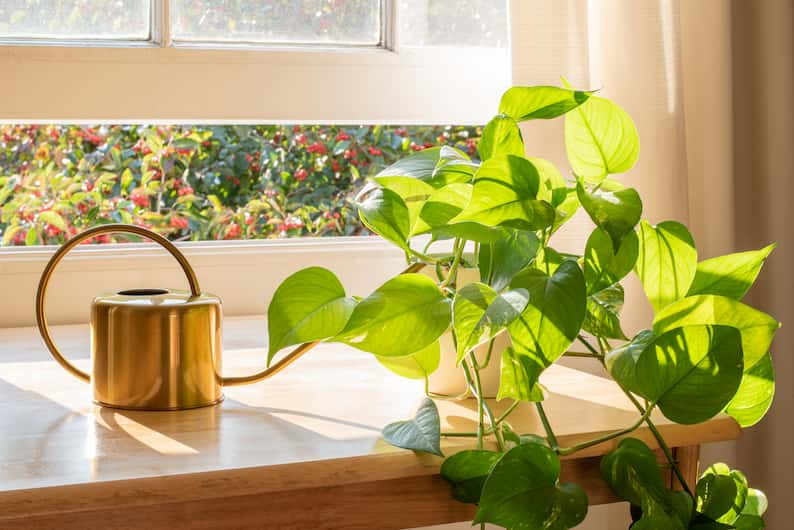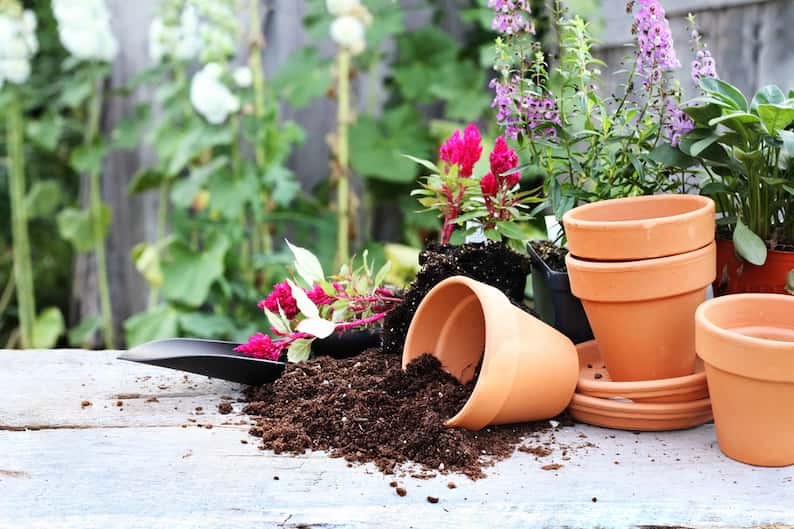Pothos is such a popular houseplant because not only does it look amazing, but it’s incredibly easy to care for.
…or at least that’s what I thought when I got my first plant. A few blackened leaves and some research later, I found out that my pothos plant really didn’t react well to having too much moisture.
So do pothos need drainage? And how do I make sure my pothos plant gets the drainage it needs? Keep reading to find out!

Table of Contents
Do pothos need drainage?
Pothos plants need drainage as they don’t need a lot of water to thrive. This means that your pothos will do best if it’s not left to sit in overly moist water, as this can promote the growth of fungus and mold, which will ultimately hurt the plant.
It’s for this reason that water needs to be able to escape from your pothos’ pot to avoid letting water pool around the roots.
Some people argue that a pothos plant doesn’t need drainage, actually, on the basis that as they don’t need much water, you can simply water them less and allow the water to sit in the pot until the soil dries out.
However, overwatering pothos is a common problem for many houseplant owners. While, sure, you could always try that strategy, it’s much better to simply ensure your pothos has drainage. That way, if you ever accidentally give it too much water or do so too frequently, the risk of this leading to major problems for your plant will drop dramatically.
Want to know more about how often to water your pothos? Take a look here!
Do pothos need well-draining soil?
Pothos need well-draining soil, which allows water and nutrients to flow easily and for the roots to grow and reach out to the necessary minerals. It particularly ensures that water cannot pool around the roots, which can be detrimental to the plant.
To reach the minerals and water it needs in the soil, the roots of the pothos need to be able to move quite easily through the soil. This means the best soil for pothos is well-draining soil.
Best soil for Pothos
Miracle-Gro Tropical Potting Mix
Light and well-draining (perfect for avoiding root rot) while being packed with just the right nutrients – that will feed your plant for up to six months. The best soil for keeping your pothos healthy and strong.
Water can become pooled in soil that isn’t well-draining and too much water can cause the roots of the pothos to rot. It also means that new, cleaner water cannot enter the soil, nor can more nutrients. Without access to these, the plants will almost certainly begin to die.
How does this work? Soil is made up of granules, organic matter, and nutrients. Between each of these elements, there are tiny gaps, or pores. It is these that allow water to flow and nutrients to move through the soil. The roots of the plant also move through these pores to reach out to get the water and nutrients they need.
Why do pothos plants need drainage?
Drainage is important for pothos so that the water around the roots can flow quite easily and not accumulate. Roots that become water-logged can develop root-rot, which will eventually kill the plant. Drainage also means that the roots of the plant can grow easily through the soil and won’t become compacted.
The roots of pothos need to be able to find gaps between the tiny elements making up the soil, to move along a path. If there is not sufficient drainage in the soil, it can become compacted and eventually turn into something resembling a slightly porous rocky surface.

The roots can become compacted in the hardened soil and will eventually become strangled together, at which point the plant is considered “root bound”. This can eventually lead to it being impossible for the roots to absorb nutrients and the plant may wilt and die.
Find out more: 7 Signs of a Root Bound Pothos (and How to Fix It)
The flip side of insufficient drainage is that water will accumulate in the pot, instead of escaping. Water-bound roots are susceptible to fungus and mold in the water and can develop root rot.
The effect of root rot is that the pothos won’t get the correct amount of water it needs. You may notice your pothos looks droopy because the roots cannot take up enough water. The net effect of this is that the leaves will blacken and the plant may eventually die.
You may also be interested in: 7 Simple Steps to Train Your Pothos to Climb
How to ensure pothos has drainage
1. Drainage holes
The easiest and best way to ensure that your pothos has drainage is to put it into a pot with holes or slits at the bottom. This will allow excess water to run away. There is, of course, the possibility that some soil may run away out of the holes, but that’s usually not a problem.
That said, if you really can’t live with that because of where the pot is located, you can prevent this from happening by putting a layer of small stones at the bottom of the pot. That way, the holes will mostly be covered, but will still allow water to drain out.
2. Use the correct potting mix
When you buy potting mix from your nursery, you should always pick one that suits the type of plant you are going to use it for. A mix that is suited to plants like pothos, that don’t need a lot of water, will contain enough absorbent material to retain some water while letting the rest drain away. Doing this lets your plant get enough moisture for your pothos to continue to grow fast.
Use the correct potting mix in your pots, and you will have a good quality soil that drains sufficiently for pothos, and which doesn’t leach out of the pot.

3. Avoid excessive bottom watering
Sometimes people stand the pot holding a houseplant in a tray of water. This is called bottom watering and is where the water moves into the soil via capillary action. The plant’s roots continuously absorb water.
That’s fine for some plants, but don’t do this excessively with your pothos. Instead, only allow your pothos to sit in the water bath until the top of the soil is visibly damp. Otherwise, the plant will keep absorbing the water and will become too wet for healthy growth.
4. Draining layer
To avoid the water pooling at the bottom of the pot and covering the roots for a long time, use a layer of something like pebbles or pumice to create a draining layer.
Can pothos survive in pots without holes?
Pothos do not need a lot of water. Their roots also need a place to expand and to avoid becoming water-logged. As such, pothos can survive in pots without holes, provided some form of layer is put between the soil and the bottom of the pot.
Pots without holes are suited to plants that usually grow in a lot of water. Pothos is not one of these plants. However, pothos can survive in pots without holes provided that a drainage layer is placed at the bottom of the pot.
To grow well and consistently, pothos do not need too much water. The important thing about the drainage layer is that it must keep the water that has drained away from direct contact with the roots of the plant. It must, therefore, be quite porous itself.
The other clue to pothos growing in pots without holes is to avoid watering them too much. A lot of water will accumulate in the pot even above the drainage layer. Allow the soil to become mostly dry before watering the plant.

